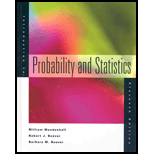Sorry! We don’t have solutions for this edition yet.
Solutions are available for other editions of this book
View 15th Edition solutionsarrow_forwardView 14th Edition solutionsarrow_forwardBook Details
Preface
Introduction: An Invitation To Statistics.
1. DESCRIBING DATA WITH GRAPHS. Variables and Data. Types of Variables. Graphs for Categorical Data. Graphs for Quantitative Variables. Relative Frequency Histograms. Key Concepts. Do It Yourself. About MINITAB--Introduction to MINITAB. Case Study: How Is Your Blood Pressure?
2. DESCRIBING DATA WITH NUMERICAL MEASURES. Describing a Set of Data with Numerical Measures. Measures of Center. Measures of Variability. On the Practical Significance of the Standard Deviation. A Check on the Calculation of s. Measures of Relative Standing. The Five-number Summary and the Box Plot. Key Concepts and Formulas. About MINITAB-Numerical Descriptive Measures. Case Study: The Boys of Summer.
3. DESCRIBING BIVARIATE DATA. Bivariate Data. Graphs for Qualitative Variables. Scatterplots for Two Quantitative Variables. Numerical Measures for Quantitative Bivariate Data. Key Concepts. About MINITAB--Describing Bivariate Data. Case Study: Do You Think Your Dishes Are Really Clean?
4. PROBABILITY AND PROBABILITY DISTRIBUTIONS. The Role of Probability in Statistics. Events and the Sample Space. Calculating Probabilities Using Simple Events. Useful Counting Rules (Optional). Event Relations and Probability Rules. Calculating Probabilities; Independence and the Multiplicative Rule. Calculating Probabilities for Intersections. Bayes' Rule (Optional). Discrete Random Variables and their Probability Distributions. The Mean and Standard Deviation for a Discrete Random Variable. Key Concepts and Formulas. About MINITAB--Discrete Probability Distributions. Case Study: Probability and Decision Making in the Congo.
5. SEVERAL USEFUL DISCRETE DISTRIBUTIONS. Introduction. The Binomial Probability Distribution. The Poisson Probability Distribution. The Hypergeometric Probability Distribution. Key Concepts and Formulas. About MINITAB-Binomial and Poisson Probabilities. Case Study: A Mystery: Cancers Near a Reactor.
6. THE NORMAL PROBABILITY DISTRIBUTION. Probability Distributions for Continuous Random Variables. The Normal Probability Distribution. Tabulated Areas of the Normal Probability Distribution. The Normal Approximation to the Binomial Probability Distribution (Optional). Key Concepts and Formulas. About MINITAB--Normal Probabilities. Case Study: The Long and Short of It.
7. SAMPLING DISTRIBUTIONS. Introduction. Sampling Plans and Experimental Designs. Statistics and Sampling Distributions. The Central Limit Theorem. The Sampling Distribution of the Sample Mean. The Sampling Distribution of the Sample Proportion. A Sampling Application: Statistical Process Control (Optional). Key Concepts and Formulas. About MINITAB--The Central Limit Theorem at Work. Case Study: Sampling the Roulette at Monte Carlo.
8. LARGE-SAMPLE ESTIMATION. Where We've Been. Where We're Going-Statistical Inference. Types of Estimators. Point Estimation. Interval Estimation. Estimating the Difference between Two Population Means. Estimating the Difference between Two Binomial Proportions. One-Sided Confidence Bounds. Choosing the Sample Size. Key Concepts and Formulas. Case Study: How Reliable Is That Poll?
9. LARGE-SAMPLE TESTS OF HYPOTHESES. Testing Hypotheses about Population Parameters. A Statistical Test of Hypothesis. A Large-Sample Test about a Population Mean. A Large-Sample Test of Hypothesis for the Difference in Two Population Means. A Large-Sample Test of Hypothesis for a Binomial Proportion. A Large-Sample Test of Hypothesis for the Difference in Two Binomial Proportions. Some Comments on Testing Hypotheses. Key Concepts and Formulas. Case Study: An Aspirin a Day?
10. INFERENCE FROM SMALL SAMPLES. Introduction. Student's Distribution. Small-Sample Inferences Concerning a Population Mean. Small-Sample Inferences for the Difference between Two Population Means: Independent Random Samples. Small-Sample Inferences for the Difference between Two Means: A Paired Difference Test. Inferences Concerning a Population Variance. Comparing Two Population Variances. Revisiting the Small Sample Assumptions. Key Concepts and Formlas. About MINITAB--Small-Sample Testing and Estimation. Case Study: How Would You Like a Four-Day Work Week?
11. THE ANALYSIS OF VARIANCE. The Design of an Experiment. What Is an Analysis of Variance? The Assumptions for an Analysis of Variance. The Completely Randomized Design: A One-Way Classification. The Analysis of Variance for a Completely Randomized Design. Ranking Population Means. The Randomized Block Design: A Two-Way Classification. The Analysis of Variance for a Randomized Block Design. The a x b Factorial Experiment: A Two-Way Classification. The Analysis of Variance for an a x b Factorial Experiment. Revisiting the Analysis of Variance Assumptions. A Brief Summary. Key Concepts and Formulas. About MINITAB--Analysis of Variance Procedures. Case Study: "A Fine Mess".
12. LINEAR REGRESSION AND CORRELATION. Introduction. A Simple Linear Probabilistic Model. The Method of Least Squares. An Analysis of Variance for Linear Regression. Testing the Usefulness of the Linear Regression Model. Inferences Concerning B, the Slope of the Line of Means. The Analysis of Variance F Test. Measuring the Strength of the Relationship: The Coefficient of Determination. Interpreting the Results of a Significant Regression. Diagnostic Tools for Checking the Regression Assumptions. Dependent Error Terms. Residual Plots. Estimation and Prediction using the Fitted Line. Correlation Analysis. Key Concepts and Formulas. About MINITAB-Linear Regression Procedures. Case Study: Is Your Car "Made in the U.S.A."?
13. MULTIPLE REGRESSION ANALYSIS. Introduction. The Multiple Regression Model. A Multiple Regression Analysis. A Polynomial Regression Model. Using Quantitative and Qualitative Predictor Variables in a Regression Model. Testing Sets of Regression Coefficients. Interpreting Residual Plots. Stepwise Regression Analysis. Misinterpreting a Regression Analysis. Steps to Follow when Building a Multiple Regression Model. Key Concepts and Formulas. About MINITAB-Multiple Regression Procedures. Case Study: "Made in the U.S.A."-- Another Look".
14. ANALYSIS OF CATEGORICAL DATA. A Description of the Experiment. Pearson's Chi-Square Statistic. Testing Specified Cell Probabilities: The Goodness-of-Fit Test. Contingency Tables: A Two-Way Classification. Comparing Several Multinomial Populations: A Two-Way Classification with Fixed Row or Column Totals. The Equivalence of Statistical Tests. Other Applications. Key Concepts and Formulas. About MINITAB--The Chi-Square Test. Case Study: Can a Marketing Approach Improve Library Services?
15. NONPARAMETRIC STATISTICS. Introduction. Mann-Whitney U Test: Independent Random Samples. The Sign Test for a Paired Experiment. A Comparison of Statistical Tests. The Wilcoxon Signed-Rank Test for a Paired Experiment. The Kruskal-Wallis H Test for Completely Randomized Designs. The Friedman F Test for Randomized Block Designs. Rank Correlation Coefficient. Summary. Key Concepts and Formulas. About MINITAB--Nonparametric Procedures. Case Study: How's Your Cholesterol Level?
Appendix I: Tables.
Answers To Selected Exercises.
Index.
Credits.
More Editions of This Book
Corresponding editions of this textbook are also available below:
